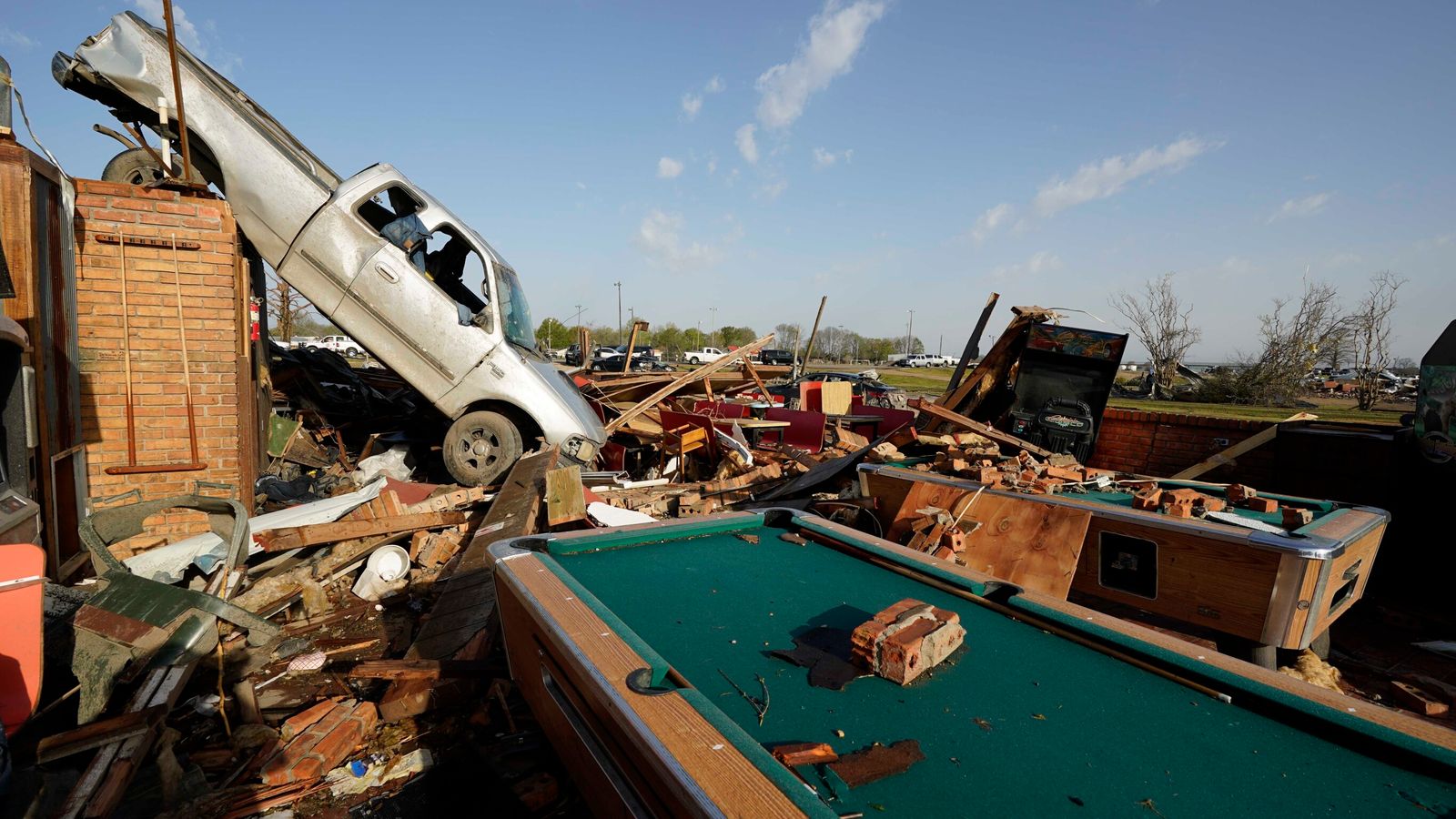Tornado kills at least 26 as it tears through southern US states during ‘supercell’ storms

At least 26 people have died after a powerful tornado ripped through several southern US states, destroying buildings and knocking out power.
The Mississippi Emergency Management Agency announced late Saturday afternoon that the number of deaths in the state had risen from 23 to 25.
Four who were missing have been found but dozens are injured.
One person was also reported dead in Alabama, making the total death toll at least 26.
Severe storms hit Mississippi, Alabama and Texas on Friday, producing hail the size of golf balls and prompting the authorities to warn residents they were in a “life-threatening situation”.
The National Weather Service issued an alert to people in the path of the tornado and said: “To protect your life, TAKE COVER NOW!
“You are in a life-threatening situation. Flying debris may be deadly to those caught without shelter… Considerable damage to homes, businesses, and vehicles is likely and complete destruction is possible.”
Please use Chrome browser for a more accessible video player
0:29
Sheriff heartbroken after relative dies in US tornado
The Mississippi Emergency Management Agency said in a Twitter post that search and rescue teams from local and state agencies were deployed to help victims impacted by the tornadoes.
The number of fatalities means the storms that ravaged parts of Mississippi overnight were the deadliest in the state in more than a decade.
The tornado caused destruction in the rural Mississippi towns of Silver City and Rolling Fork on Friday night before continuing to sweep northeast towards Alabama at 70mph.
Rolling Fork Mayor Eldridge Walker told CNN that his town was essentially wiped out.
Video shot as daylight broke showed houses reduced to piles of rubble, cars flipped on their sides and trees stripped of their branches. Occasionally, in the midst of the wreckage, a home would be spared, seemingly undamaged.
“My city is gone. But we are resilient and we are going to come back strong,” Mr Walker said.
Read more: Photos show how deadly storm has reduced buildings to rubble
Please use Chrome browser for a more accessible video player
0:40
Dozens of people have died after a powerful tornado hit
People were trapped in piles of rubble and damage had caused gas leaks in Rolling Fork, local newspaper Vicksburg News reported the Sharkey County Sheriff’s Office as saying.
President Biden said in a statement: “Jill and I are praying for those who have lost loved ones in the devastating tornadoes in Mississippi and for those whose loved ones are missing.
“The images from across Mississippi are heartbreaking. While we are still assessing the full extent of the damage, we know that many of our fellow Americans are not only grieving for family and friends, they’ve lost their homes and businesses.”
Shelters were opened for those whose homes were damaged by the storms.
Read more:
Rare tornado strikes LA suburb as ‘bomb cyclone’ smashes US
California floods: Atmospheric river brings snow, strong winds and flooding
Please use Chrome browser for a more accessible video player
0:50
‘It’s really bad’ – Residents hit by tornado
The damage in Rolling Fork was so widespread that several storm chasers – who follow severe weather and often put up livestreams showing dramatic funnel clouds – pleaded for search and rescue help. Others abandoned the chase to drive injured people to the hospitals themselves.
The Sharkey-Issaquena Community Hospital on the west side of Rolling Fork was damaged, WAPT reported.
Some law enforcement units were unaccounted for in Sharkey County where Rolling Fork is based, according to local media.
According to poweroutage.us, 40,000 customers were without power in Tennessee; 15,000 customers were left without power in Mississippi; and 20,000 were without power in Alabama.
The storms in Mississippi were not as deadly as those that left 31 people dead in the state in April 2011.
In Texas, two tornadoes with 100mph winds struck around 5am on Friday, leaving five people injured.
Please use Chrome browser for a more accessible video player
0:19
WTVA meteorologist Matt Laubhan was overwhelmed as tornado hit
The initial storm was a “supercell”, which brews the deadliest tornadoes and most damaging hail, said University of Northern Illinois University meteorology professor Walker Ashley.
Friday’s storm was a night time, wet one which is “the worst kind”, he said.
Earlier on Friday a car was swept away and two passengers drowned in Missouri during torrential rain that was part of a severe weather system.
By early Saturday, tornado watches remained in parts of eastern Mississippi and in northern Alabama, according to the weather service. Earlier, those watches covered almost all of Mississippi.